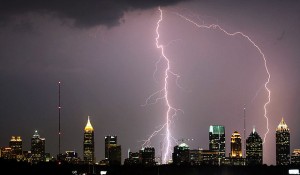You’ve probably heard about the “urban heat island”, which is a pocket of warm temperatures created by pavement and buildings in the center of cities. It’s not surprising that Atlanta and other large cities have well-documented “heat islands” that make the cities warmer than surrounding areas. A bit more surprising is that even moderate sized cities of only 100,000 citizens and even smaller towns can also have heat island effects if there is significant concrete and pavement in their central cores.
But did you know that cities can also contribute to the creation of local weather conditions, too? One story in Atlanta magazine today documents the increase in thunderstorm development over the city of Atlanta compared to surrounding cities. Based on the analysis of radar echoes, the scientists (from Northern Illinois University and the University of Georgia) showed that thunderstorms start more often over the city core than surrounding areas. This is due in part to the extra heat generated by the cities, which can enhance convective activity. Other factors may include the surface roughness caused by tall buildings and the pollution levels in the cities.
I’ve also noticed that storms occur more frequently downwind of Atlanta; sometimes you can guess the wind direction from looking at where the storms are forming on days when there is no front in the area.
